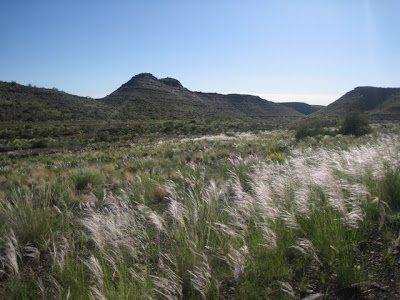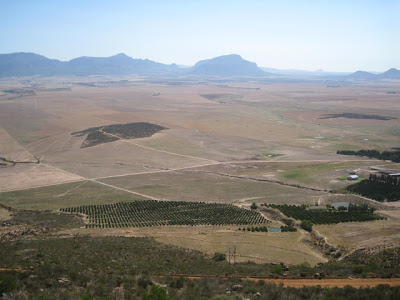 Sesriem Canyon, carved by the Tsauchab River
Sesriem Canyon, carved by the Tsauchab River Thursday, February 28, 2008
On the road from Sesriem to Swakopmund, Namibia (February 28, 2009)
 Sesriem Canyon, carved by the Tsauchab River
Sesriem Canyon, carved by the Tsauchab River More photos of Sesriem and Sossusvlei, Namibia (February 27, 2008)
 Dramatic dunes with acacia trees in the foreground
Dramatic dunes with acacia trees in the foreground People climbing up the massive dunes (look for the small dots just to the right of the middle of the photo)
People climbing up the massive dunes (look for the small dots just to the right of the middle of the photo) "Dead Vlei" - the white area is where water once ran hundreds of years ago, allowing trees to grow. Because the desert is so dry, when the trees eventually died, they simply remained standing. Some of the trees in this photo are between 600 and 900 years old!
"Dead Vlei" - the white area is where water once ran hundreds of years ago, allowing trees to grow. Because the desert is so dry, when the trees eventually died, they simply remained standing. Some of the trees in this photo are between 600 and 900 years old! A closer view of one of the dead trees
A closer view of one of the dead trees Yet another beautiful African sunset
Yet another beautiful African sunset Sesriem and Sossusvlei, Namibia (February 27, 2008)
Most of Western Namibia is covered by a 32,000 square km sand sea, and the most famous dunes are within the Namib-Naukluft National Park. Sossusvlei is Namibia's number one tourist attraction, and it's easy to see why - the pink dunes (some as high as 200m) are stunningly beautiful set against a brilliant blue sky.
As the sun rose over the dunes, the early morning light turned the sand from a pale yellow-pink color to a bright orange-pink, with stark shadows. Closer to midday, with the sun high overhead, the dunes settled into a uniform soft pink color with only faint shadows.
The desert was equally beautiful at sunset (when the sky turned yellow, orange, pink and purple) and at night (when the sky was filled with the most stars I've ever seen). I even saw a shooting star! In addition to the gorgeous scenery, there was plenty of interesting wildlife - gemboks (also known as oryx), springboks, jackals, geckos and ostriches.
 Sunrise at the dunes
Sunrise at the dunes
 Interesting patterns in the sand
Interesting patterns in the sand
 Dunes as far as the eye can see, fading from orange to pink
Dunes as far as the eye can see, fading from orange to pink
 As the sun rose over the dunes, they turned this bright orange color. Note the people at the top of each of the peaks - they'll give a sense of the size of the dunes.
As the sun rose over the dunes, they turned this bright orange color. Note the people at the top of each of the peaks - they'll give a sense of the size of the dunes.
 A dead tree at the base of the dunes
A dead tree at the base of the dunes
As the sun rose over the dunes, the early morning light turned the sand from a pale yellow-pink color to a bright orange-pink, with stark shadows. Closer to midday, with the sun high overhead, the dunes settled into a uniform soft pink color with only faint shadows.
The desert was equally beautiful at sunset (when the sky turned yellow, orange, pink and purple) and at night (when the sky was filled with the most stars I've ever seen). I even saw a shooting star! In addition to the gorgeous scenery, there was plenty of interesting wildlife - gemboks (also known as oryx), springboks, jackals, geckos and ostriches.
 Sunrise at the dunes
Sunrise at the dunes Interesting patterns in the sand
Interesting patterns in the sand Dunes as far as the eye can see, fading from orange to pink
Dunes as far as the eye can see, fading from orange to pink As the sun rose over the dunes, they turned this bright orange color. Note the people at the top of each of the peaks - they'll give a sense of the size of the dunes.
As the sun rose over the dunes, they turned this bright orange color. Note the people at the top of each of the peaks - they'll give a sense of the size of the dunes. A dead tree at the base of the dunes
A dead tree at the base of the dunesFish River Canyon to Sesriem, Namibia (February 26, 2008)
The drive north from Fish River Canyon National Park to Sesriem was long, bumpy and surprisingly beautiful. The region had recently seen a lot of rain, and many of the hills were bright green with new grass. There were also more trees, shrubs and wildflowers than I had expected. The contrast of the greenery, the red soil and the blue sky was quite picturesque.
 Long grasses along the side of the road
Long grasses along the side of the road Namibian wildflowers
Namibian wildflowers Blue sky, green hills, red soil
Blue sky, green hills, red soil An acacia tree with several sociable weaver (bird) nests
An acacia tree with several sociable weaver (bird) nests
Another gorgeous African sunset
Fish River Canyon, Namibia (February 25, 2008)
Fish River Canyon claims to be the second largest canyon in the world, and at 160km long, 27km wide and 550m deep, it certainly looks impressive. The canyon is protected within a namesake national park in the southwestern region of Namibia. The surrounding desert plains are dry and rocky, and are home to some interesting plants and animals. I was thrilled to see a herd of zebras running in the wild, surprisingly camouflaged in their black and white stripes.
Western Cape and Orange River, South Africa (February 23-24, 2008)
The landscape along the Western Cape is beautiful and varied. The area is known for its sweeping coastline, its vineyards and its adventure sports. We spent one night at a campsite in the Olifants River Valley, where we sampled the local wines of the Klawer Wynkelder coop winery.
On the second night, we camped at the Orange River, which marks the northwestern border between South Africa and Namibia, and is a popular destination for rafters and campers. From the South African side, one can see the dry Namibian desert in the distance.
 Looking down on the Olifants River Valley, with its many vineyards
Looking down on the Olifants River Valley, with its many vineyards
 The road north along the Western Cape...at one point, we saw ostriches running along the highway!
The road north along the Western Cape...at one point, we saw ostriches running along the highway!
 The Orange River at sunset - Namibia is just a short swim away
The Orange River at sunset - Namibia is just a short swim away The Orange River area at sunrise
The Orange River area at sunrise
On the second night, we camped at the Orange River, which marks the northwestern border between South Africa and Namibia, and is a popular destination for rafters and campers. From the South African side, one can see the dry Namibian desert in the distance.
 Looking down on the Olifants River Valley, with its many vineyards
Looking down on the Olifants River Valley, with its many vineyards The road north along the Western Cape...at one point, we saw ostriches running along the highway!
The road north along the Western Cape...at one point, we saw ostriches running along the highway! The Orange River at sunset - Namibia is just a short swim away
The Orange River at sunset - Namibia is just a short swim away The Orange River area at sunrise
The Orange River area at sunrise
Entering Namibia
More photos of Cape Town, South Africa (February 22-23, 2008)
 An old sign on display at the District Six museum in Cape Town. The museum is dedicated to the tens of thousands of residents who were removed from their homes in the Sixth Municipal District of Cape Town when it was declared a whites-only area in the 1960s under the apartheid regime.
An old sign on display at the District Six museum in Cape Town. The museum is dedicated to the tens of thousands of residents who were removed from their homes in the Sixth Municipal District of Cape Town when it was declared a whites-only area in the 1960s under the apartheid regime. Laundry drying in a township courtyard
Laundry drying in a township courtyard Two boys stand in a shanty town on the outskirts of a township
Two boys stand in a shanty town on the outskirts of a township Makeshift dwellings constructed of everything from corrugated iron to cardboard
Makeshift dwellings constructed of everything from corrugated iron to cardboard Another view of the shanty town beside Cape Town's main highway
Another view of the shanty town beside Cape Town's main highway Cape Town, South Africa (February 22-23, 2008)
Cape Town is a colorful city on the southwestern coast of South Africa. The downtown area is easily walkable, and the architecture is vaguely reminiscent of that of New Orleans or Charleston, South Carolina, with pastel buildings and fancy wrought-iron balconies. Long Street, the main thoroughfare in city center, is crammed with trendy shops and cafes, interspersed with the odd antique store or traditional African clothing shop.
Cape Town's most famous landmark is Table Mountain - a 1086m high flat-topped (hence the name) mountain that seems to have its own weather system. While the rest of Cape Town was blue and sunny, the top of Table Mountain was perpetually shrouded in swirling clouds.
On Friday, I wandered around downtown, looked at a craft market, went part way up Table Mountain, walked through the beautiful Kirstenbosch botanical gardens and had afternoon tea at the famous Mount Nelson hotel.
On Saturday, I visited the District Six museum and went to see Cape Town's oldest township. The township was a stark contrast to the posh downtown I'd seen the day before. I'll let the pictures speak for themselves:
Cape Town's most famous landmark is Table Mountain - a 1086m high flat-topped (hence the name) mountain that seems to have its own weather system. While the rest of Cape Town was blue and sunny, the top of Table Mountain was perpetually shrouded in swirling clouds.
On Friday, I wandered around downtown, looked at a craft market, went part way up Table Mountain, walked through the beautiful Kirstenbosch botanical gardens and had afternoon tea at the famous Mount Nelson hotel.
On Saturday, I visited the District Six museum and went to see Cape Town's oldest township. The township was a stark contrast to the posh downtown I'd seen the day before. I'll let the pictures speak for themselves:
 The view of Cape Town from Table Mountain
The view of Cape Town from Table Mountain
The cable car station at the top of Table Mountain. The cable car is often closed due to clouds or high winds, and it wasn't running the day I visited.

A weary craftswoman taking a quick nap between customers
Wednesday, February 20, 2008
On the road again
The grand adventure begins anew: tonight (and tomorrow...and part of the next day) I'll be making my way from San Francisco to Cape Town. It was hard to leave my family and friends again after such a short time at home, but I'm excited for what lies ahead - Africa, the Middle East and Europe!
I don't know how much Internet access I'll have over the next two months, but I'll post photos (and at least text) when possible. Stay tuned!
I don't know how much Internet access I'll have over the next two months, but I'll post photos (and at least text) when possible. Stay tuned!
Wednesday, February 6, 2008
Photos of Santiago IV (January 29 - February 1, 20...
Photos of Santiago III (January 29 - February 1, 2008)
 The statue of the Virgen de la Inmaculada Concepción looks down over Santiago from the top of San Cristobal Hill.
The statue of the Virgen de la Inmaculada Concepción looks down over Santiago from the top of San Cristobal Hill. The view of downtown Santiago from San Cristobal Hill...somewhere in the distance should be mountains.
The view of downtown Santiago from San Cristobal Hill...somewhere in the distance should be mountains. The colorful and lively Bellavista neighborhood is home to the Universidad de Chile, La Chascona (poet Pablo Neruda's Santiago abode) and many restaurants, bars and jazz clubs.
The colorful and lively Bellavista neighborhood is home to the Universidad de Chile, La Chascona (poet Pablo Neruda's Santiago abode) and many restaurants, bars and jazz clubs. A mural of Pablo Neruda near his home in Barrio Bellavista. Neruda, who won the Nobel Prize in 1971, was a poet, a diplomat, a communist politician and an avid collector of random and interesting items that are displayed in his three Chilean homes: dolls, nautical instruments, playing cards and, of course, books.
A mural of Pablo Neruda near his home in Barrio Bellavista. Neruda, who won the Nobel Prize in 1971, was a poet, a diplomat, a communist politician and an avid collector of random and interesting items that are displayed in his three Chilean homes: dolls, nautical instruments, playing cards and, of course, books.




















